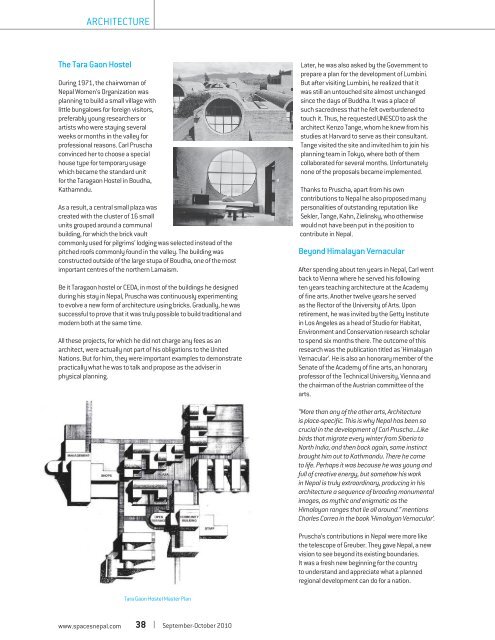5. September - October 2010
You also want an ePaper? Increase the reach of your titles
YUMPU automatically turns print PDFs into web optimized ePapers that Google loves.
ARCHITECTURE<br />
The Tara Gaon Hostel<br />
During 1971, the chairwoman of<br />
Nepal Women’s Organization was<br />
planning to build a small village with<br />
little bungalows for foreign visitors,<br />
preferably young researchers or<br />
artists who were staying several<br />
weeks or months in the valley for<br />
professional reasons. Carl Pruscha<br />
convinced her to choose a special<br />
house type for temporary usage<br />
which became the standard unit<br />
for the Taragaon Hostel in Boudha,<br />
Kathamndu.<br />
As a result, a central small plaza was<br />
created with the cluster of 16 small<br />
units grouped around a communal<br />
building, for which the brick vault<br />
commonly used for pilgrims’ lodging was selected instead of the<br />
pitched roofs commonly found in the valley. The building was<br />
constructed outside of the large stupa of Boudha, one of the most<br />
important centres of the northern Lamaism.<br />
Be it Taragaon hostel or CEDA, in most of the buildings he designed<br />
during his stay in Nepal, Pruscha was continuously experimenting<br />
to evolve a new form of architecture using bricks. Gradually, he was<br />
successful to prove that it was truly possible to build traditional and<br />
modern both at the same time.<br />
All these projects, for which he did not charge any fees as an<br />
architect, were actually not part of his obligations to the United<br />
Nations. But for him, they were important examples to demonstrate<br />
practically what he was to talk and propose as the adviser in<br />
physical planning.<br />
Later, he was also asked by the Government to<br />
prepare a plan for the development of Lumbini.<br />
But after visiting Lumbini, he realized that it<br />
was still an untouched site almost unchanged<br />
since the days of Buddha. It was a place of<br />
such sacredness that he felt overburdened to<br />
touch it. Thus, he requested UNESCO to ask the<br />
architect Kenzo Tange, whom he knew from his<br />
studies at Harvard to serve as their consultant.<br />
Tange visited the site and invited him to join his<br />
planning team in Tokyo, where both of them<br />
collaborated for several months. Unfortunately<br />
none of the proposals became implemented.<br />
Thanks to Pruscha, apart from his own<br />
contributions to Nepal he also proposed many<br />
personalities of outstanding reputation like<br />
Sekler, Tange, Kahn, Zielinsky, who otherwise<br />
would not have been put in the position to<br />
contribute in Nepal.<br />
Beyond Himalayan Vernacular<br />
After spending about ten years in Nepal, Carl went<br />
back to Vienna where he served his following<br />
ten years teaching architecture at the Academy<br />
of fine arts. Another twelve years he served<br />
as the Rector of the University of Arts. Upon<br />
retirement, he was invited by the Getty Institute<br />
in Los Angeles as a head of Studio for Habitat,<br />
Environment and Conservation research scholar<br />
to spend six months there. The outcome of this<br />
research was the publication titled as ‘Himalayan<br />
Vernacular’. He is also an honorary member of the<br />
Senate of the Academy of fine arts, an honorary<br />
professor of the Technical University, Vienna and<br />
the chairman of the Austrian committee of the<br />
arts.<br />
“More than any of the other arts, Architecture<br />
is place-specific. This is why Nepal has been so<br />
crucial in the development of Carl Pruscha...Like<br />
birds that migrate every winter from Siberia to<br />
North India, and then back again, some instinct<br />
brought him out to Kathmandu. There he came<br />
to life. Perhaps it was because he was young and<br />
full of creative energy, but somehow his work<br />
in Nepal is truly extraordinary, producing in his<br />
architecture a sequence of brooding monumental<br />
images, as mythic and enigmatic as the<br />
Himalayan ranges that lie all around.” mentions<br />
Charles Correa in the book ‘Himalayan Vernacular’.<br />
Pruscha’s contributions in Nepal were more like<br />
the telescope of Greuber. They gave Nepal, a new<br />
vision to see beyond its existing boundaries.<br />
It was a fresh new beginning for the country<br />
to understand and appreciate what a planned<br />
regional development can do for a nation.<br />
Tara Gaon Hostel Master Plan<br />
www.spacesnepal.com 38<br />
<strong>September</strong>-<strong>October</strong> <strong>2010</strong>

















